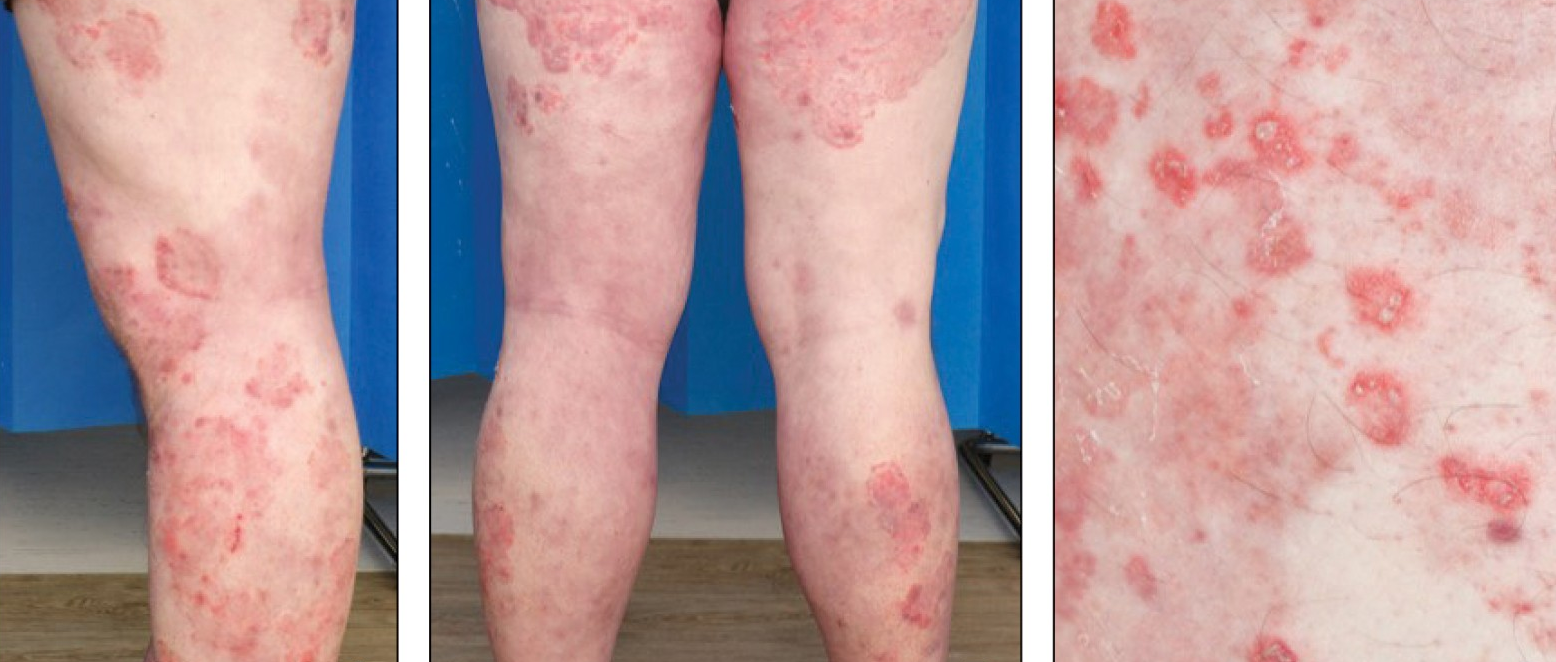
A 68-year-old Caucasian woman presents with a two-year history of an erythematous and intensely pruritic rash that she thinks is psoriasis.
She first noted the rash on her feet and lower legs, and it has since spread to her groin, abdomen and arms.
She had scalp psoriasis in early adulthood which responded to tar-based shampoos. She has not needed any further treatment for this for around 40 years.
Believing this new presentation to be recurrence of psoriasis, she treated the rash with Advantan or Daviobet cream twice daily for two years.
These controlled the pruritus initially, but the rash gradually spread and became more painful and pruritic. This is now limiting her activities of daily living and disrupting sleep.
On examination, there are scattered erythematous annular patches on her groin, lower legs and arms.
There is marked erythema of the pubic region extending to the upper thighs, with an arcuate spreading border.
There is an approximately 7cm well demarcated heterogeneously erythematous annular plaque on her abdomen, with raised and erythematous borders, which demonstrates central clearing with post-inflammatory hyperpigmentation.
What is the most likely diagnosis?
Correct!
Tinea incognito describes fungal skin infection, the appearance of which has been altered by immunosuppressive therapies.
This may be due to pre-existing immunosuppressive medications prescribed for other conditions; or the rash may have been misidentified and incorrectly treated with topical steroids or other immunosuppressive agents, as in this case.
These treatments change the appearance of the rash and may efface some of the more characteristic features of fungal infection.
Compared with untreated tinea corporis, tinea incognito tends to be more extensive, erythematous, pruritic and pustular and may also lack the scale and raised borders that characterise untreated tinea corporis.
As with other fungal skin infections, this condition can affect patients of any demographic. Increasing access to over-the-counter topical steroid creams may increase the prevalence of this condition.
Tinea incognito warrants consideration when there is a history of a rash that initially responded to treatment but relapses with withdrawal of treatment.
Clinically, the appearance of tinea incognito can vary greatly and may mimic various skin conditions, including systemic lupus erythematosus, eczema, contact dermatitis, psoriasis, seborrheic dermatitis and erythema migrans.
Tinea infection can be diagnosed with fungal microscopy and culture and testing should generally be performed prior to commencing treatment to identify the pathogen and confirm the diagnosis. The lack of scale can complicate the collection of fungal scrapings.
Any topical immunosuppressants should be discontinued if feasible. The infection itself should first be treated with standard antifungal therapy, although systemic treatment may be required.
In this case, the patient was advised to stop applying the topical immunosuppressant therapies and was prescribed topical terbinafine 1% twice daily.
In addition, she was prescribed oral terbinafine 250mg once daily after her FBC, EUC and LFT were reviewed and no contraindications to oral antifungal therapy was found.
Considering the extensive nature of the fungal rash, a glucose tolerance test was also performed, which was normal.
